One reason why this recipe rocks and that sets it apart from other fudge recipes: it doesn’t call for specific chocolate temperatures.
Depending on the recipe, the temperature of certain ingredients can indisputably impact and even entirely alter the outcome of the recipe. But as in this case, it’s not always the most realistic; not everyone has a thermometer to heat and cool the chocolate to the prescribed ranges. That’s not to knock the recipes that do require precise temperatures – it’s warranted and the fudge is presumably delicious – it’s just that there were 2 stipulations I insisted on meeting when creating this recipe:
- The fudge is simplified and practical. The more straightforward a recipe is, the more feasible it is for everyone.
- An objective for all recipes – that it is healthier. Upon investigation, a majority of healthier fudge recipes include nut butter; likely to help achieve the notable fudgy texture that we all adore. But including peanut butter would then make it peanut butter fudge, in my eyes. So a healthier, traditional fudge free from any unconventional ingredients was the second condition.
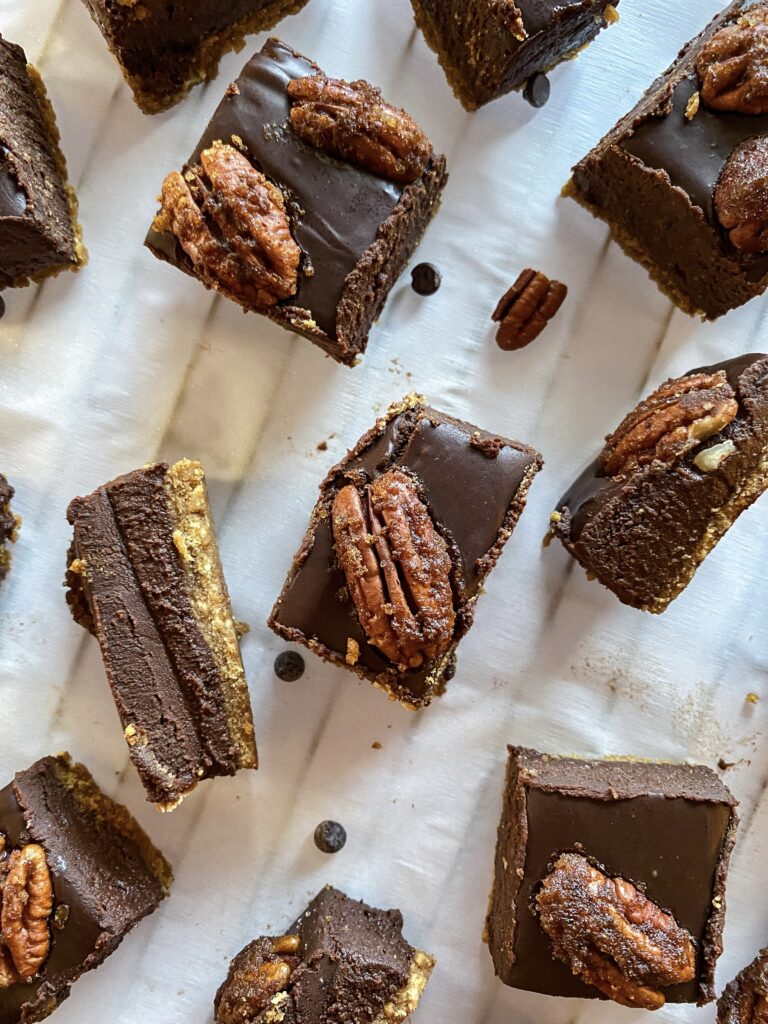
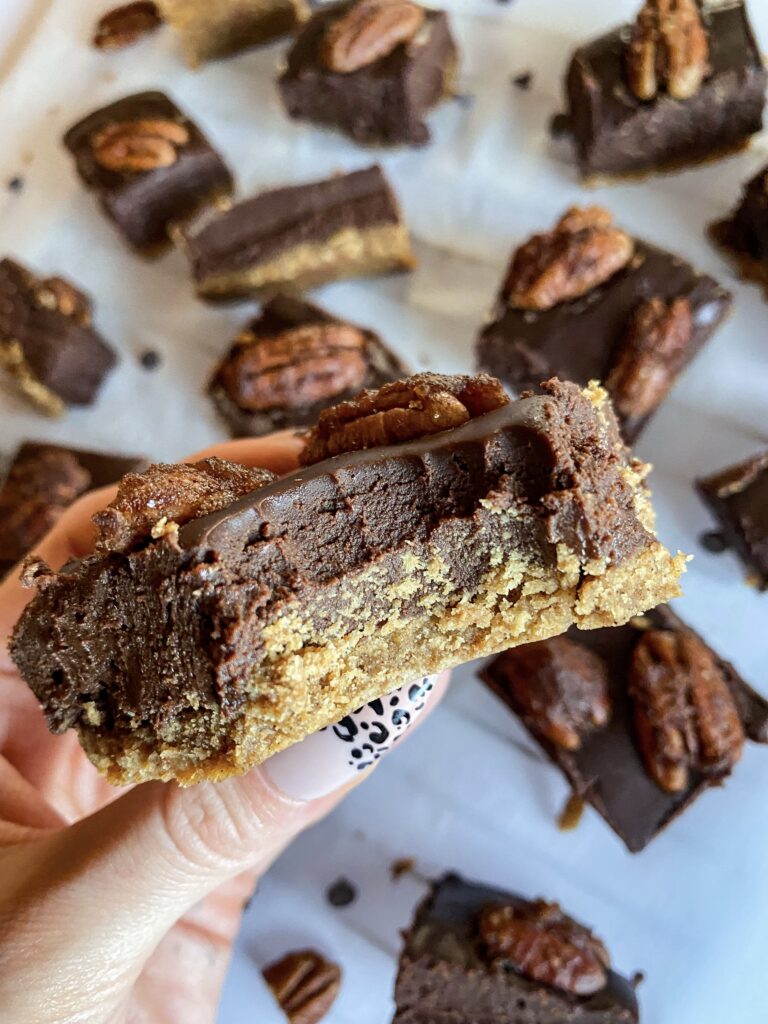
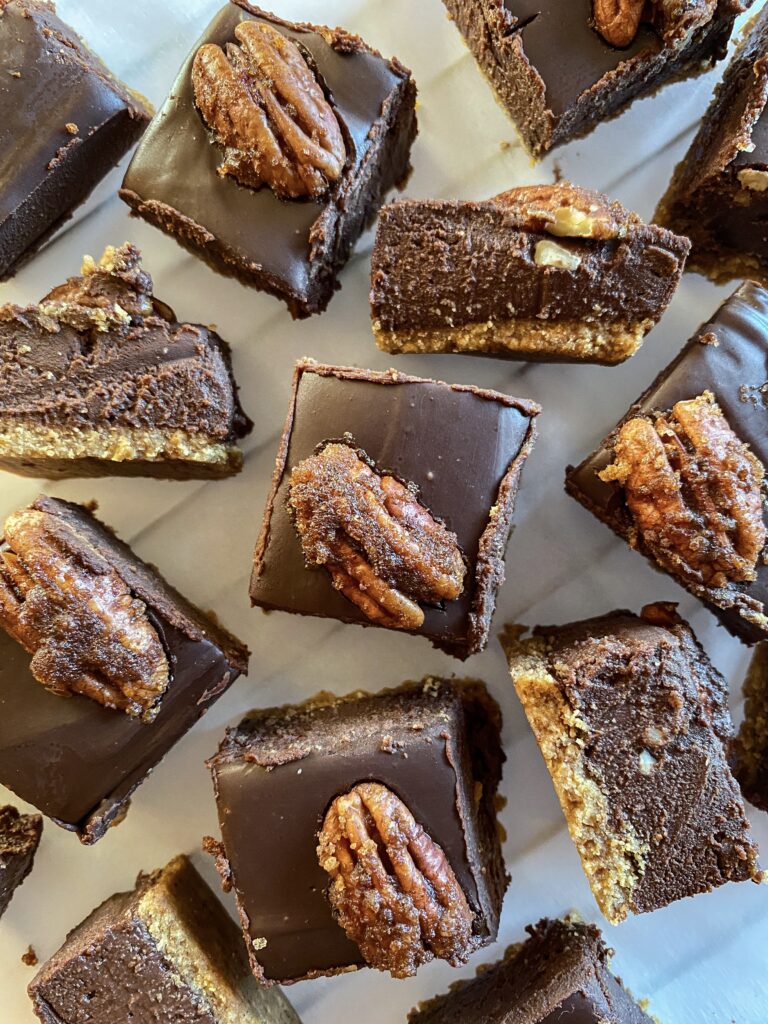
Now while this recipe doesn’t push for exact temperatures, it does request that particular brands are used for two of the ingredients. Singling out name brands in the ingredient list and strongly recommending their use is far from common in SUNutrition recipes – Dairy-Free Peach Froyo is only other one that comes to mind that does so. Know that it’s for good reason and not personal preferences or promotional purposes (in which there are zero commissions or affiliations with the brands listed below). The reason being that through the trial and error that goes into the final product you see, some brands were found to produce better results than others; the select brands are identified so that you can reproduce this recipe as closely and as accurately as possible! I acknowledge this does slightly impede on the first stipulation of making a more accessible, feasible recipe, but once you sink your teeth into this creamy, decadent fudge, you’ll understand the brand bias.
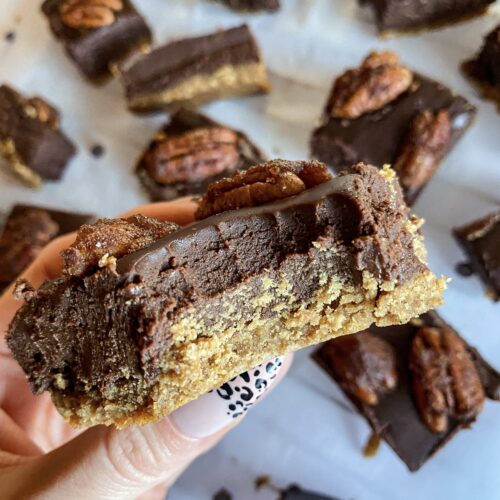
Chocolate Pecan Pie Fudge
Ingredients
Crust
- 120 g graham crackers*
- 2 tsp. oil: walnut, coconut, almond, or other neutral flavored oil
- 3 TBSP unsweetened dairy-free milk any kind
- ½ tsp. cinnamon
Fudge
- 18 oz. chocolate* (Enjoy Life)
- 9 oz. unsweetened dairy-free yogurt* (So Delicious)
- 3 TBSP oil: walnut, coconut, almond, or other neutral flavored oil
- ½ tsp. vanilla
Topping
- 1 handful of (~30 g) raw pecans
- 1 TBSP stevia brown sugar
- Dash of cinnamon
- Small bowl of water
Instructions
- Finely crush the graham crackers by placing the crackers in a: Ziploc bag and rolling over it with a rolling pin, baggie or deep bowl using the bottom of a glass jar, or food processor
- Transfer the crushed graham crackers to a mixing bowl, add the other crust ingredients, and fold and press together until the mixture is combined
- Line a pan (8×8, 9×9, or even a bread loaf pan will work) with parchment paper, evenly press the crust mixture along the bottom of the pan, then let it set in the fridge (for ~1 hour)*
- Put all of the fudge ingredients except the vanilla in a microwave-safe bowl and melt in 15-30 second increments – stirring thoroughly between each, only returning it to the microwave when the chocolate no longer continues to melt from stirring – until smooth, then stir in the vanilla*
- If you’re topping with raw pecans or leaving the fudge plain, skip this step: take two small bowls or containers and mix the Stevia brown sugar and cinnamon together in one, and add 1” or so of water to the other, then set aside
- Remove the crust from the fridge, then pour and spread the melted chocolate mixture evenly on top of the crust
- If you’re leaving the fudge plain, skip this step. If you’re using raw pecans or another topping, add the topping(s) now. Otherwise, one at a time, dip a pecan into the bowl of water, roll it in the cinnamon and sugar mixture until it’s fully coated, then lightly place it on top of the fudge
- Move the fudge to the fridge and allow it to set until it’s firm throughout, then it’s ready to eat – continue to store the fudge in the fridge*
Notes
- *Graham crackers: any kind works, but if you’re wanting more natural ingredients, try Kodiak Graham Bear Bites or looking for an allergen-friendly one, KinniKinnick is an option
- *Chocolate and yogurt: Enjoy Life and So Delicious are the two brands implied in the opening, immediately before the ingredients – other brands, particularly chocolates, were tested and these yielded the best consistency
- *3. Letting it set in the fridge for about an hour isn’t completely necessary, so if you don’t have the time to spare, you can get by without doing so
- *4. A customary method for tempering chocolate in the microwave without a thermometer is to use a similar method of short 30 second bursts and stirring between each, only instead to start with ~⅔-¾ of the chocolate, melting that accordingly, then incorporate the remaining unmelted chocolate, and stir until it’s completely melted
- *8. The fudge will typically set overnight but to speed up the process, position the fudge in the coolest part of the fridge
- This recipe can also be made vegan; the only non-vegan ingredient is the graham crackers, so if a vegan-friendly brand is used (such as the Kinnikinnick ones mentioned earlier), then the fudge is fit for vegans!
Making fudge without a thermometer can be finicky – I’ve had a few batches come out too soft. When that happens, it generally means the chocolate wasn’t heated for long enough. If the cooking time is too brief, then not enough water gets evaporated and too much water causes the fudge to be soft and a little messy to eat. Without getting into the intricacies, that is one of the many motives why thermometers and precision are heeded in fudge recipes. But not to worry, even if your fudge turns out softer than you’d like, I can guarantee (speaking from experience) it won’t go to waste, especially if you have a dessert-lover nearby! And don’t let it discourage you from trying again; practice makes perfect as they say.
You can’t ever go wrong with fudge. And one of the best features of fudge is the flexibility. You can do away with the crust and candied pecans to make classic chocolate fudge. From there, you can leave it as is or get creative with the flavors: white chocolate drizzle, peanut butter swirl, sprinkles, dried fruit, almond slivers and shredded unsweetened coconut, caramel layer with flaky sea salt.
So rich, smooth, and incredibly addicting, this dairy-free fudge is sure to be a family favorite and holiday hit; enjoy!
If interested, the macronutrients are below. They are kept separate at the very end of each recipe blog so that this can remain a safe, positive space for all as not everyone wishes to see the nutritional information.
Macros:
To preface, fudge and other sweets are meant to be savored, not rigidly tracked. At times, the ingredients should be the primary focus, rather than the calories and numbers.
In regards to this fudge, could it have been made even healthier? Yes. But would it taste as much like the real deal? Now that’s iffy. To do so would mean sacrificing the aforementioned conditions and compromising the mantra of all SUNutrition recipes: tastes too good to be healthy.
Sometimes, making a recipe healthier means improving the quality of the ingredients. A standard fudge recipe calls for a combination of any of the following: chocolate, butter, sugar, sweetened condensed milk, vanilla, marshmallows. When compared to the ingredients in this fudge, the ingredients here are more natural, less processed, and better than the former for overall health – which is more imperative than macros.
So with that being said, take these macros lightly; with a ~grain of salt~ if you will.
Whole batch, with the crust and toppings: 393.89 C | 274.87 F | 59.51 P
Whole batch, without the crust and toppings: 319.8 C | 220.5 F | 35.325 P
To figure out the macros of each individual piece, there are two ways to go about it. The first would be to divide the macros of the whole batch by the # of pieces cut. Though the con of this method is it may be hard to cut equal pieces depending on the placement of the pecans. The other option would be to weigh the entire batch of fudge once it has set (either in ounces or grams) and divide the total macros by the weight to determine the macros per ounce or gram. Then weigh the piece in question and multiply that weight by the previously calculated macros per ounce or gram to determine the macros for that piece.
The macros for recipes are also available on MyFitnessPal. Simply search the name of the recipe followed by “ – SUNutrition” (so for this recipe, search “Chocolate Pecan Pie Fudge – SUNutrition”).
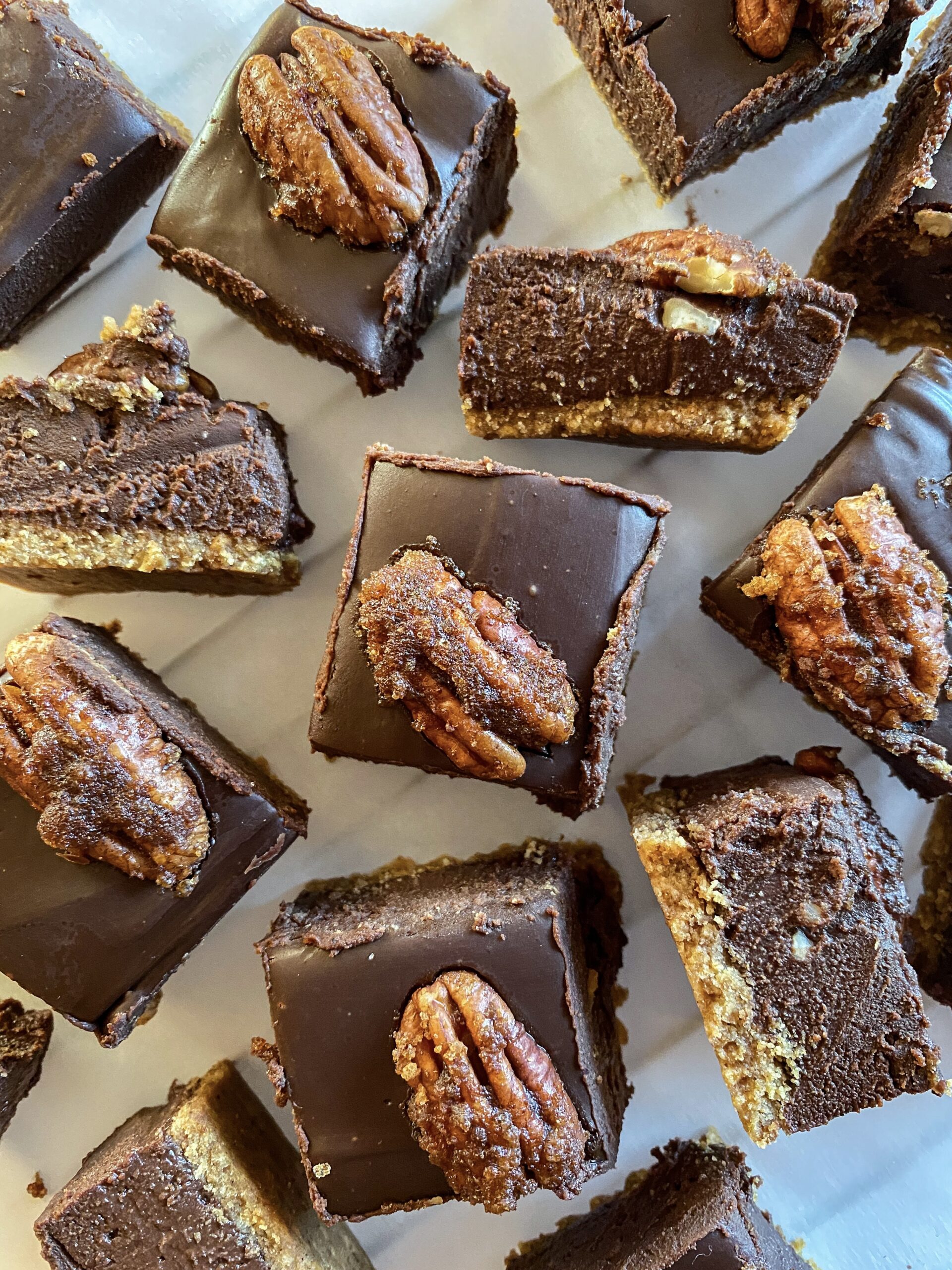
Im very happy to uncover this site. I wanted to thank you for ones time for this particularly wonderful read!! I definitely appreciated every bit of it and i also have you book marked to see new information in your site.
Excellent blog post. I certainly love this website. Keep it up!